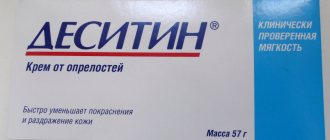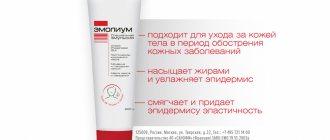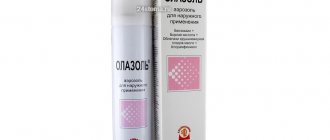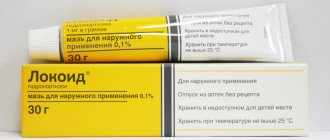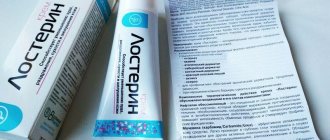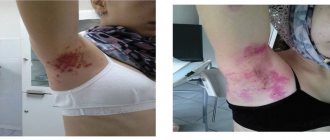The appearance of topical corticosteroids (GCS) in the early 50s of the last century is considered one of the most significant events in dermatology. And today, drugs of this group occupy a leading position among all external dermatological drugs [1]. A wide range of indications, high activity, pleiotropic effects and a convincing evidence base, along with a favorable safety profile, are a solid foundation for the rapid movement towards the heights of popularity of these drugs among doctors and consumers. As a result, first-line physicians need to keep in mind and be able to use knowledge about the drugs of this group in pharmaceutical consulting. Especially considering that some topical drugs containing corticosteroids are available without a prescription. How local glucocorticosteroids work, when they can be recommended, and what to warn clients about is in our new article.
We say pleiotropic, we mean multiple
The mechanism of action of local corticosteroids is based on their ability to interact with corticosteroid-specific receptors, which are located in the epidermis and fibroblasts of human skin. At the same time, they exhibit a complex of different effects, exerting a pleiotropic (multiple - editor's note) effect due to the implementation of a number of mechanisms [2].
Anti-inflammatory effect
Provides the benefits of topical corticosteroids for inflammatory skin lesions.
Mechanisms:
- Inhibition of the release of phospholipase A2, the main enzyme for the formation of inflammatory mediators based on arachidonic acid (prostaglandins and leukotrienes).
- Inhibition of transcription factors that are involved in the activation of proinflammatory genes.
- Inhibition of phagocytosis and stabilization of membranes of phagocytic cells.
- Decreased release of keratinocytes and the pro-inflammatory cytokine interleukin-2 from epidermal principal cells.
Immunosuppressive effect
Provides the anti-inflammatory effect of topical corticosteroids.
Mechanisms:
- Suppression of the production of mediators involved in the inflammatory response (tumor necrosis factor, interleukins and some others).
- Inhibition of leukocyte migration to the site of inflammation.
- Interference with the function of endothelial cells, granulocytes, mast cells and fibroblasts.
Antiproliferative effect aimed at suppressing the excessive proliferation of certain cells.
Provides the effectiveness of topical glucocorticosteroids in conditions accompanied by abnormally high skin proliferation, for example, psoriasis or eczema.
Mechanism:
- Inhibition of DNA synthesis and mitosis.
- Inhibition of fibroblast activity and collagen formation.
Vasoconstrictor effect
Provides high activity of topical corticosteroids for dermatological diseases accompanied by skin redness and swelling.
The mechanism of this effect is still not fully understood. One of its stages is the inhibition of pro-inflammatory mediators that have a vasodilatory effect (histamine, bradykinin, prostaglandin, etc.). Vasoconstrictor activity has become one of the criteria for assessing the power of topical GCS.
Activity of topical corticosteroids
The activity of drugs in this group depends on at least four factors [2, 4].
Release form.
The release form of a local drug is in its own way a “vehicle” that ensures the delivery of active substances deep into the skin. Therefore, the “power” of the topical agent largely depends on its properties.
- Ointments with steroids
are considered the most effective form of topical corticosteroids. These are water-in-oil emulsions, the high activity of which is due to the ability to form a film on the surface of the skin that is impenetrable to air and moisture and thus provides a “compress effect” - occlusion. As a result, the local concentration and effectiveness of the product increases. But occlusive preparations also have disadvantages: firstly, the skin stops “breathing”, which can contribute to the development of weeping, and secondly, they are inconvenient to apply to the skin of the scalp, chest, etc.
It is advisable to recommend topical corticosteroids in the form of ointments for the treatment of dry skin diseases.
- Creams
, unlike ointments, being an “oil in water” emulsion, are not fatty forms. They do not form an occlusive film on the surface of the skin and therefore lack both the disadvantages of ointments and their advantages. GCS creams are less active than steroid ointments.
Topical corticosteroids in the form of a cream are indicated for acute and subacute inflammation without significant weeping.
- Gels
- an oil-in-water emulsion with an alcohol base. They liquefy upon contact with skin and have a medium degree of activity.
It is advisable to recommend gels for the treatment of areas of the body heavily covered with hair.
- Lotions
, which are aqueous solutions, are considered the least active form of GCS. They evaporate, providing a cooling effect.
It is advisable to recommend topical GCS in the form of a lotion if it is necessary to treat large areas, as well as areas abundantly supplied with hair follicles.
The salt to which the steroid is bound.
For example, betamethasone exists as valerate, dipropionate, and benzoate, each of which has different potencies.
Active ingredient concentration
The higher the concentration of the active substance, the higher the activity of the drug.
For example, one of the most powerful topical corticosteroids, clobetasol propionate, in the form of an ointment, is approximately 1000 times “more powerful” than the weakest drug in this group, 1% hydrocortisone.
There are two classifications of topical corticosteroids according to the degree of activity - European, which distinguishes 4 classes, and American, in which drugs are divided into 7 classes of activity. In both the first and second, activity was assessed based on vasoconstrictor tests and according to clinical studies.
European classification of topical glucocorticosteroids [3]
| Class (degree of activity) | INN |
| IV – very strong | Clobetasol 0.05% cream, ointment |
| III – strong |
|
| II – medium strength | Alclomethasone 0.05% ointment, cream |
| I – weak |
|
American classification of topical corticosteroids [3]
| Class (degree of activity) | INN |
| I – very strong | Clobetasol 0.05% cream, ointment Betamethasone (dipropionate) 0.1% cream, ointment; 0.05% cream, ointment |
| II – strong | Mometasone (furoate) 0.1% ointment, cream, solution Triamcinolone acetonide 0.1% ointment |
| III – moderately strong | Betamethasone (valerate) 0.1% cream, ointment Fluticasone (propionate) 0.005% ointment, 0.05% cream |
| IV – medium strength | Fluocinolone acetonide 0.025% ointment, cream, gel, liniment Mometasone (furoate) 0.1% ointment, cream, solution Triamcinolone acetonide 0.025% ointment Methylprednisolone aceponate 0.1% fatty ointment, ointment, cream, emulsion |
| V – medium strength | Betamethasone (valerate) 0.1% cream Hydrocortisone (butyrate) 0.1% ointment, cream, emulsion, solution Fluocinolone acetonide 0.025% cream, gel, liniment |
| VI – medium strength | Alclomethasone (dipropionate) 0.05% ointment, cream |
| VII – weak | Hydrocortisone (acetate) 0.5%, 1% ointment Prednisolone 0.5% ointment |
Indications and contraindications
List of indications
, for which the use of topical steroid drugs (GCS) is advisable, is quite extensive. The most common indications for their use are:
- psoriasis;
- atopic dermatitis;
- eczema;
- seborrheic dermatitis;
- contact dermatitis.
The choice of a specific drug depends, first of all, on the disease and the location of the lesion. Depending on the type of pathology and the area that needs to be treated, the active component, dosage form, and concentration are selected.
For example, high-strength topical corticosteroids are used to treat exacerbations of alopecia areata, resistant atopic dermatitis, hyperkeratotic eczema, lichen planus, severe contact dermatitis and severe hand eczema [5].
Topical corticosteroids of medium strength are used for severe anal inflammation, dry eczema, atopic eczema in children, atopic dermatitis, seborrheic dermatitis and a number of other diseases [5].
Topical corticosteroids classified as “weak” are indicated for diaper dermatitis (severe), as well as eyelid dermatitis and intertrigo (dermatitis in skin folds) [5].
Topical steroids can be prescribed both for exacerbations of dermatological diseases before the onset of a period of remission, and for the treatment of chronic inflammatory process.
Contraindications
for the use of topical corticosteroids are:
- · Acute infectious skin lesions - topical corticosteroids, having immunosuppressive properties, inhibit the healing process [2];
- · Strong and super-strong steroid drugs should not be used on the face, groin and axillary areas. Their use under a bandage is contraindicated to avoid the development of an occlusive effect. As a rule, drugs of these groups are used for a short period [5].
Protopic ointment for external use 0.1% 30g tube
Compound
Ointment for external use 100 g
active substance:
tacrolimus (as tacrolimus monohydrate) 0.03/0.1 g
excipients: soft white paraffin; liquid paraffin; propylene carbonate; white beeswax; paraffin paraffin
Pharmacological action - anti-inflammatory, immunosuppressive.
Pharmacodynamics
Tacrolimus belongs to the group of calcineurin inhibitors. It binds to a specific cytoplasmic protein immunophilin (FKBP12), which is a cytosolic receptor for calcineurin (FK506). As a result, a complex is formed that includes tacrolimus, FKBP12, calcium, calmodulin and calcineurin, which leads to inhibition of the phosphatase activity of calcineurin. This makes it impossible to dephosphorylate and translocate the nuclear factor of activated T cells (NFAT), which is necessary to initiate transcription of genes encoding the production of cytokines key to the T-cell immune response (IL-2 and interferon-gamma). In addition, tacrolimus inhibits the transcription of genes encoding the production of cytokines such as IL-3, IL-4, IL-5, granulocyte-macrophage colony-stimulating factor (GMCSF) and TNF-α, which are involved in the initial stages of T-lymphocyte activation. In addition, under the influence of tacrolimus, the release of inflammatory mediators from mast cells, basophils and eosinophils is inhibited, as well as the expression of FcεRI (high-affinity surface receptor for IgE) on Langerhans cells is reduced, which leads to a decrease in their activity and antigen presentation to T lymphocytes.
Tacrolimus ointment does not affect collagen synthesis, etc. does not cause skin atrophy.
Indications for Protopic:
Protopic ointment is used in dosages of 0.03 and 0.1% in adults and only 0.03% in children from 2 to 16 years of age for the treatment of atopic dermatitis (moderate and severe forms) in case of resistance to other means of external therapy or the presence of contraindications to such.
Directions for use and doses
Externally. For adults and children over 2 years of age, Protopic ointment is applied in a thin layer to the affected areas of the skin. The drug can be used on any part of the body, including the face and neck, in the area of skin folds. The drug should not be applied to mucous membranes or under occlusive dressings.
Before use, consultation with a specialist is required.
The method of administration and dosage regimen of a particular drug depend on its release form and other factors. The optimal dosage regimen is determined by the doctor.
Storage mode, interactions and side effects are indicated in the instructions.
Side effects of topical glucocorticosteroids
This question often worries consumers. So that first-principals can quickly and easily dispel customer doubts, we have created several convincing arguments in the format of dialogues with customers.
- It is better not to use hormones, even externally, as they have many side effects.
Answer:
Most drugs in this group are well tolerated. Side effects, as a rule, develop when using high-strength topical corticosteroids when treating large areas over a long period of time [2].
- Hormonal ointments are also absorbed into the blood, so it is better to do without them.
Answer:
Modern topical corticosteroids have extremely low absorption and are practically not absorbed into the blood, acting locally at the site of inflammation.
- It is better not to use hormonal ointments to treat children - they can become addictive.
Answer:
Topical corticosteroids, which are approved for use in pediatric practice, for example, methylprednisolone aceponate, are practically not absorbed into the blood, acting locally at the site of inflammation. When used, as a rule, the condition is very quickly alleviated and the likelihood of relapse of the disease is reduced. The main thing is to observe the frequency of application and course of treatment.
Returning to the question of side effects of topical corticosteroids, it should be noted that the most common adverse reaction is skin atrophy. It manifests itself in the form of thinning of the skin, shine, telangiectasia, bruising, stretch marks, redness and changes in pigmentation. Hydrocortisone aceponate, fluticasone propionate and methylprednisolone aceponate have the lowest ability to cause skin atrophy. Therefore, they can be used to treat lesions on the face, scrotum, and large areas of the body, including in children [2].
To minimize the likelihood of side effects, topical corticosteroids are recommended to be used in short courses (no more than 3–4 weeks). As the duration of treatment increases, the likelihood of adverse reactions increases.
When using topical glucocorticosteroids in infants, it should be remembered that application of drugs into the folds of the skin and under the diaper may be accompanied by the development of an occlusive effect and a local increase in the concentration of the active component. In this regard, it is not recommended to apply drugs in places where diapers and diapers come into contact with the skin [6].
What should I warn the client about?
When dispensing the drug, it is appropriate to note:
- To reduce the risk of side effects, it is very important to strictly follow the doctor’s recommendations: observing the frequency of use, dosage and course of treatment. It is strictly prohibited to arbitrarily change the duration of treatment and increase the dose.
- Replacing one steroid drug with another without the knowledge of the doctor can lead not only to a decrease in the effectiveness of treatment, but also to the development of side effects of GCS, since only a specialist who takes into account several factors can select them correctly.
Allergy ointment for external use Astellas "Protopic" - reviews
(alina2014) Alina
https://www.imho24.ru/recommendation/11123/#review9473
Advantages:
Effective.
Flaws:
Expensive.
Review:
My daughter has been suffering from atopic dermatitis for several years; the disease appears only at the same time in winter; spots similar to lichen appear on the skin. Until recently, there was no treatment, everything went away on its own within a week, but now the dermatologist prescribed treatment with this remedy in combination with dietary supplements and allergy pills. Of course, in such cases it is necessary to identify the allergen due to which the exacerbation is progressing, but it is also impossible to leave the skin in this state. The result is noticeable already on the second day of use, which indicates its effectiveness, but it is worth noting that the drug has side effects. Itching and redness may appear on the skin, as stated in the instructions. When purchasing, I advise you to pay attention to the percentage: 0.1 - for adults, 0.03 - for children over two years old, contraindicated for infants. In pharmacies it costs about 1,500 rubles, a little expensive, but, according to the doctor, it has no analogues.
Anna
https://med-otzyv.ru/lekarstva/158-p/35824-protopik#scomments
The worst thing is when your child is sick, and what is doubly worse is when the child cannot eat what is tasty and is constantly covered in red spots and is embarrassed to appear on the street. This is where the wonderful Protopic ointment came to our aid. It was recommended to us at the hospital as a remedy for these hated red spots. We were prescribed to use Protopik for almost two weeks, but I didn’t believe that Protopik worked in literally three days. Of course, Protopic is not a cheap ointment, but it is very effective.
Maria Kobets
https://health.mail.ru/drug/protopik/
The only ointment that helped. Of course, it can be very difficult to endure it, because the skin begins to itch very much after use, but there is a result! but it’s not suitable for everyone, as the doctor told me.
Lena
https://www.medcentre.com.ua/protopik.html
I have neurodermatitis and the doctor prescribed many different medications, some of them did not help at all, others a little. As a result, the doctor prescribed me Protopic ointment. This drug is prescribed when practically nothing helps. The ointment is very greasy and in the end it turns out to be economical. But Protopic ointment has a lot of side effects. I read the reviews on the Internet and thought about it. It is even prescribed to children! Of course, there are different situations, and mothers probably resort to such ointments. I tried it on myself. Yes, it also helped me to some extent, the skin is very moisturized and cracks and irritations go away. But there may also be side effects such as severe itching. Protopic ointment helps me, but I need to carefully read the instructions and use it carefully, paying special attention to contraindications.
Mariana
https://xlebez.ru/maz-astellas-farma-protopik/
I suffered and suffered with my skin after childbirth and this cream was one of the few that somehow helped me. This ointment is produced in Ireland, which is why it is not cheap: 10 g - 700 rubles. And there is also a bigger tube. There are also 2 concentrations of this ointment: 0.03% - for children after 2 years and for adults 0.1%. Naturally, I had a second one. This ointment is indicated for severe, difficult-to-treat forms of neurodermatitis. I had exactly that case. Severe itching, scratching, dryness, redness all over the body. These words contained my whole nightmare - to say that I felt bad is to say nothing. So my doctor advised me to try Protopic. These 15g. were a “drop in the ocean” for my whole body - but the price is not small - I took a small volume to try. To my delight, it is very economical, its greasy texture allows it to be spread well. This is a hormonal cream and of course all the side effects associated with the use of glucocorticosteroids are present, but they occur much less frequently. Among other things, a contraindication is tanning in the sun (solariums, medical ultraviolet radiation, etc.) during the entire course of treatment. This is worth paying attention to - this is written in the instructions, but not everyone reads it carefully and, unfortunately, not all doctors warn about this. He helps very well and most importantly quickly. When applied, it is very pleasant for dry skin, does not sting when scratched, and softens cracked and irritated skin well. In general, he became a real salvation for me. Be healthy everyone, don't get sick. But if something happens, keep it in mind, the drug is good and effective.
viktoriyakozir
https://otzovik.com/review_4546672.html
Advantages:
good effect
Flaws:
expensive
Good day, dear friends. And again about ointments. Protopic 0.3% is an ointment for children over two years of age for the treatment of atopic dermatitis, most importantly, on any part of the body, including the face and neck. Before this ointment, we used other hormonal drugs, but this ointment does not disrupt the body’s hormonal processes. It is cloudy in color, similar in consistency to Vaseline, and has no odor. With the help of this ointment, spots and redness disappear from my child’s skin, and this is the most important thing. The ointment is not cheap, the cost of a 10 gram package is 700 rubles, and the cost of 30 grams is 2000 rubles, which is expensive. I wish everyone good health. Thanks for your attention, bye everyone.
KrisArvada
https://otzovik.com/review_3495236.html
Advantages:
there is an effect
Flaws:
helps, but very slowly, price
Recently I was diagnosed with such a bad disease as vitiligo. It’s certainly not fatal, and it doesn’t hurt, but in my opinion it’s more of a mental trauma. Especially for a girl. But I have already successfully survived the period of depression, my complexes have disappeared, and in general I continue to live as I always did. I don’t pay attention to the spots, but I still treat them. The main lesion was on my face. Therefore, my goal now is not just to get rid of existing ones, but to prevent further growth of white spots throughout the body. I was prescribed a course of treatment. One of them is Protopic cream. It is not cheap (250 hryvnia). They prescribed it to me on the same day that they diagnosed me with vitiligo. Of course, I immediately ran to the pharmacy and bought everything that was prescribed for me. Only at home I read the instructions for it and realized that it was not for vitiligo at all, but for atopic dermatitis. I was immediately upset, but still decided to follow the dermatologist’s recommendations. I use this cream twice a day, morning and evening. I read on the Internet that yes, this cream is indeed prescribed for vitiligo, although there is not a word about it in the instructions. So, with this disease, the immune system attacks melanocytes (cells that synthesize melanin), because it perceives them as a threat to the body. Melanocytes disappear and white spots appear. This process helps to stop Protopic. It is not absorbed into the skin of the face. This cream is quite oily, so you only need a little bit. Therefore, its consumption is small. Most of all, this ointment fights spots on the face, or rather, best of all. But be sure if you use this ointment, then you need to sunbathe a little and first spread it on the skin. Then the result will be better and more effective. I can say that after a month of use, the results became noticeable. My spots on my forehead have especially decreased; they have become much smaller in diameter. Other spots have acquired more of a skin color, so to speak, but have not yet completely disappeared. For now I still continue to use it. At the same time, I also follow a diet. In my diet every day there is a good bunch of parsley and dill (I eat these greens instead of bread, I have given up bread altogether). Plus, I eat as many bananas, raspberries, black currants, tomatoes, and peppers as possible. Well, it’s still summer, there are a lot of fruits and vegetables, so I’m taking advantage of the opportunity. I don’t know what will happen next. Still, I hope that before winter I will get rid of my stains. In general, if you were prescribed Protopic for Vitiligo, then do not doubt its effect. Feel free to use it for treatment. I recommend.
MASTERPRO1995
https://otzovik.com/review_1924263.html
Advantages:
Relieves itching, peeling, redness. The ointment is not hormonal, but is as effective as hormones.
Flaws:
High price. May cause cancer if used continuously.
I learned about Protopic ointment when I encountered such an unpleasant problem as atopic dermatitis. The ointment does its job well, replaces hormonal ointments, which is a very good alternative for those who do not want to use them, and is also well suited for small children.
Zhelezyachka
https://otzovik.com/review_5471695.html
Advantages:
Helps!
Flaws:
Harmful, you need to use it in doses!
Prescribed by an allergist, the child was 4 months old. I was simply horrified by the instructions and side effects, but looking at my son also broke my heart, I couldn’t help but itch all over, red terrible spots, a rash. They prescribed us the following regimen: Advantan in the morning, Protopic in the evening, and so on for five days. Then, remove Advantan, leave only Protopic and apply it every other day, and every day apply Lipikar Baume. This scheme helped us heal our wounds. The skin gradually acquired a normal color. You need to apply it very thinly. We had no side effects. Now sometimes we also lubricate it. Once the inflammation has gone, you can leave only the moisturizer.
ArLety
https://irecommend.ru/content/edinstvennaya-negormonalnaya-maz-pri-atopicheskom-dermatite-no-nado-vse-vzvesit
A little over a year ago, we finally found out what exactly causes my husband’s allergies... No, we didn’t guess with coffee grounds, but managed to:
- Visit an allergist at the allergy and asthma center and get tested, including for parasites. And hear “pay attention to what you react to and limit it - the tests are clean.” It was for these words that we paid almost 7 tr, yeah...
- Take scrapings several times for fungus - the dermatologist was sure that the laboratory was spoiling the sample.
- Take a course of hormonal ointments to treat atopic dermatitis.
- An allergist-immunologist, who based on “scratches” and not blood, gave a list of allergens and prescribed treatment.
And now, after the introduction of complementary foods, my son begins to regularly comb his lower leg... Restrictions on my diet have changed little, changing caring cosmetics has not given any results. Panic in the ranks, which was fueled by grandparents, I’m sure I’m quietly eating candy or giving citrus to the baby..
Therefore, when the Allergist-Immunologist said that he was ready to see our son, I was already rushing to the appointment.
~~~~~~~~~~~~~~~~~ Essence of analysis ~~~~~~~~~~~~~~~~~~
Micro scratches are made on an open area of skin (for children - the back, for adults - the arm from the elbow to the wrist, the inner side), onto which the allergen is applied. The reaction is monitored for 5 minutes. Thus, you can be sure that the laboratory did not “spoil” anything and the analysis was actually carried out and gave a certain result.
At the appointment, the doctor dissuaded us from tests because
- After 3 years of age, children outgrow a number of allergies.
- It may be worth taking a course of bifidobacteria to normalize microflora and intestinal function, which will reduce controversial reactions to food.
- Tests can give a false reaction, because immune systems are just being formed. Therefore, don't waste your money.
~~~~~~~~~~~~~~~~~ Test results ~~~~~~~~~~~~~~~~~
But I insisted, because my husband is allergic, and if the child also has allergies or a mild allergic reaction to food, I want to explain to the grandmothers why something is not allowed, period.
The scratches showed a reaction to wheat flour, tangerines, and hake. Two out of three products are allergens for his father.
~~~~~~~~~~~~~~~~~~~~ Treatment ~~~~~~~~~~~~~~~~~~~
Among the doctor's prescriptions, Creon orally - to normalize the microflora and Protopic 0.03% externally - to relieve itching. Instead of this ointment, the doctor suggested considering the option “take any hormonal ointment, mix 1:3 with fatty baby cream and use”; it will be cheaper.
But Protopic is better because it is a non-hormonal treatment for dermatitis and is suitable for children from 2 to 16 years old.
The ointment itself is thick and transparent. You only need a little bit of it, which means this 30 g tube will last for several months with regular use. I’ve used it 5-7 times since March, my son stops scratching almost immediately, and within a day the scratch area becomes smooth.
Compound:
tacrolimus (in the form of monohydrate) 30 mg Excipients: white soft paraffin, liquid paraffin, propylene carbonate, white beeswax, solid paraffin
Indications
- treatment of atopic dermatitis (moderate and severe forms) in case of insufficient response of patients to traditional methods of treatment or the presence of contraindications to them. In adults, 0.03% and 0.1% Protopic® ointment is used, in children from 2 to 16 years old - 0.03% ointment
Side effects
Local reactions: very often - burning and itching sensation; often - a feeling of warmth, redness, pain, irritation, rash at the site of application. As a rule, they are moderate and disappear within the first week after the start of treatment. Infections: often - herpetic infection (herpes simplex of the face and lips, Kaposi's varicelliform rash). Dermatological reactions: often - folliculitis, itching; rarely - acne. From the peripheral nervous system: often - paresthesia, hyperesthesia.
Contraindications
- genetic defects of the epidermal barrier, such as Netherton's syndrome;
- generalized erythroderma (due to the risk of a progressive increase in systemic absorption of tacrolimus);
- pregnancy;
- lactation period (breastfeeding);
- children and adolescents up to 16 years of age (for 0.1% ointment);
- children under 2 years of age (for 0.03% ointment);
- hypersensitivity to tacrolimus, to excipients, to macrolides.
Protopic® should be used with caution in cases of decompensated liver failure, with extensive skin lesions, especially over long courses, as well as in children.
A significant disadvantage of this product is the price - at the time of purchase, in March of this year, I found it in a pharmacy for 1930 rubles...
And I bought it anyway, but I’m not sure that there will be no side effects from the hormonal ointment mixed on the eye. Or they will differ from the possible side effects of this ointment
Whether to buy or not, I cannot and will not recommend, there are too many nuances, and I do not have a medical education.
AlbaFelis
https://irecommend.ru/content/kak-protopik-vylechil-moi-atopicheskii-dermatit-foto-kozhi
I was diagnosed with atopic dermatitis at the age of 16-17 years (now -23). It all started with spots that more closely resembled eczematous inflammation. Localization: elbow pits, wrists, face. Unfortunately, there are no photos left from those times, because in fits of anger I deleted them all. Well, who would like to look at themselves in the mirror and be horrified every morning. I was a rather complex girl, but atopic dermatitis made everything much worse.
They always treated me comprehensively, based on tests: no allergens were detected, courses of IV drips, hormonal ointments, talkatives, lotions. And every time it got worse and worse.
At the age of 19, I saw a good dermatologist. In the complex treatment, we noticed hormonal ointments on Protopic, with boric acid lotions, proper nutrition and exercise, the disease began to recede.
I always have Protopic 0.1% in my medicine cabinet; I dilute it with Vaseline in a ratio of (4:1) and apply a thin, thin layer to the affected areas at night.
It was not possible to achieve a complete clinical recovery; very rarely dermatitis manifests itself, but only during periods when I catch a cold or am poisoned by something (that is, at times when there is obvious toxicosis).
After the disease, a noticeable capillary network remained on the face, the skin became more sensitive and picky about caring and decorative cosmetics. There are no traces of the rash in other places, the only thing is: I still can’t wear watches or bracelets (psychosomatic itching begins), but if I’m distracted by something, it goes away.
I am very pleased with this ointment and as a doctor (even though I am a dentist, I understand many aspects) I consider it a good replacement for hormonal therapy.
There is no point in giving quotes on the ingredients, side effects, etc. I don’t see the point, this data can be found in the description of the drug.
Specifically, I had no side effects, the only thing was: at the very beginning of using it, when I applied it every day, the first days there was a slight exacerbation, but then the affected areas were completely cleared of this nightmare (I was warned about this effect by the doctor, and followed all the rules of treatment) .
And one more thing, dear girls, never apply decorative cosmetics to inflamed areas of the skin, be it dermatitis or something else, do not abuse your body.
+ photo of the facial skin now (nose and cheeks: spider veins), I couldn’t find a photo of my dermatitis, but it’s for the best, why scare people. I’ll just say that before it was painful to look at the face.
Selected representatives of topical GCS
The list of drugs used in this group is quite large, so we will note the features of only those drugs that have over-the-counter forms.
Hydrocortisone
- a weak synthetic GCS, appropriate for use in acute and subacute skin processes without weeping. To improve penetration, it is recommended to apply with light massaging movements. When positive dynamics appear, the frequency of use is reduced from 1–3 times a day to 2–3 times a week. Approved for use in children over 2 years of age in courses of no longer than 7 days in minimally effective doses [6].
Alclomethasone
- GCS from weak to moderate degree of activity. Absorption through the skin depends on the integrity of the skin and the type of dosage form. In healthy people, 3% alklometasone is absorbed within 8 hours. Can be used on delicate and sensitive areas of the body - face, neck, chest, genital area. Recommended for acute and subacute inflammatory diseases, including those accompanied by weeping. Can be used during pregnancy (under medical supervision), breastfeeding, and in children over 6 months. The maximum duration of treatment in children is 3 weeks.
Betamethasone dipropionate
- strong corticosteroids, when used on the face, the course of treatment should not exceed 5 days to avoid the development of rosacea, perioral dermatitis or acne. Can be used in children from 1 year of age according to strict indications and under medical supervision.
Methylprednisolone aceponate
— GCS of medium strength, can be used in children from 4 months of age in courses of up to 4 weeks. It is available in the form of an emulsion, cream, ointment and fatty ointment, which allows you to select the drug individually, depending on the lesion.
Sources
- Adaskevich V. P. Local corticosteroids in the treatment of skin diseases // Bulletin of Pharmacy, 2006. No. 3. P. 33.
- Bardal, Stan K. Applied pharmacology / Elsevier Saunders, 2011.
- Clinical guidelines “Atopic dermatitis in children.” Union of Pediatricians of Russia. 2016. 60 p.
- Kondratieva T.S., Ivanova L.A., Zelikson Yu.I. Technology of dosage forms: Textbook in 2 volumes. Volume 1. Medicine. Moscow, 1991. 496 p.
- Kalyuzhnaya L. D. Should systemic side effects of topical corticosteroids be taken into account? //Ukrainian Journal of Dermatology, Venereology, Cosmetology, 2010. Vol. 1. No. 36. P. 28-31.
- According to GRLS data as of September 25, 2019.
Protopic®
For adults and children over 2 years of age, Protopic® ointment is applied in a thin layer to the affected areas of the skin. The drug can be used on any part of the body, including the face and neck, in the area of skin folds. The drug should not be applied to mucous membranes or under occlusive dressings.
Application v children (2 years and older) and adolescents under 16 years of age
Treatment should begin with the application of 0.03% Protopic® ointment twice a day. The duration of treatment under this regimen should not exceed three weeks. Subsequently, the frequency of use is reduced to once a day, treatment continues until the lesions are completely cleared.
Application v adults and adolescents 16 years and older
Treatment should begin with the use of 0.1% Protopic® ointment twice a day and continue until the lesions are completely cleared. As you improve, you can reduce the frequency of applying 0.1% ointment or switch to using 0.03% Protopic® ointment. If symptoms of the disease recur, treatment with 0.1% Protopic ointment should be resumed twice a day. If the clinical picture allows, an attempt should be made to reduce the frequency of use of the drug, or use a lower dosage - 0.03% Protopic® ointment.
Application v elderly people (65 years and older)
There are no special features for use in elderly people.
Improvement is usually observed within one week from the start of therapy. If there are no signs of improvement during therapy within two weeks, a change in therapeutic tactics should be considered.
Treatment of exacerbations
Protopic® ointment can be used short-term or long-term in the form of periodically repeated courses of therapy.
Treatment of the affected areas of the skin is carried out until the clinical manifestations of atopic dermatitis completely disappear. As a rule, improvement is observed during the first week of treatment. If signs of improvement are not observed within two weeks of starting to use the ointment, other options for further treatment should be considered.
Treatment should be resumed when the first signs of exacerbation of atopic dermatitis appear.
To prevent exacerbations and increase the duration of remission in patients with a history of frequent (more than 4 times a year) exacerbations of the disease, maintenance therapy with Protopic® ointment is recommended. The advisability of prescribing maintenance therapy is determined by the effectiveness of previous treatment according to a standard regimen (2 times a day) for no more than 6 weeks.
During maintenance therapy, Protopic® ointment should be applied 2 times a week (for example, on Monday and Thursday) to areas of the skin usually affected by exacerbations.
The time interval between application of the drug should be at least 2-3 days. Adults and adolescents 16 years of age and older use 0.1% Protopic® ointment, and children (2 years and older) use 0.03% Protopic® ointment. If signs of exacerbation appear, you should switch to the usual regimen of therapy with Protopic® ointment (see section “Treatment of exacerbations”).
After 12 months of maintenance therapy, it is necessary to evaluate the clinical dynamics and decide on the advisability of continuing the prophylactic use of Protopic® ointment. In children, to assess clinical dynamics, the drug should be temporarily discontinued and then the need to continue maintenance therapy should be considered.

